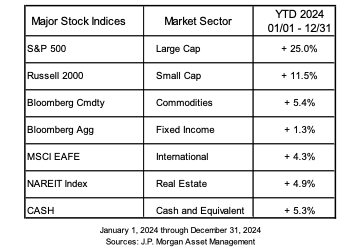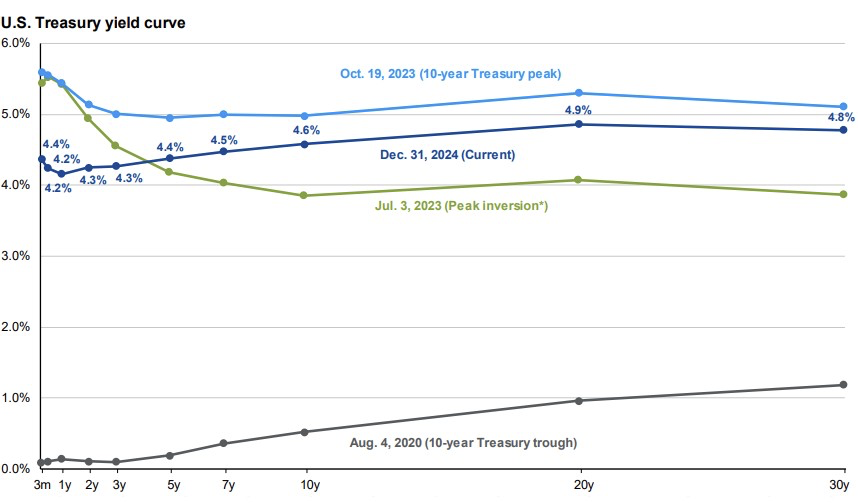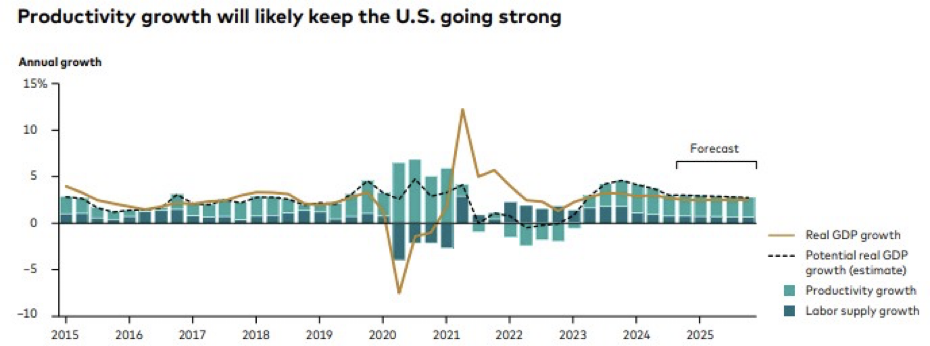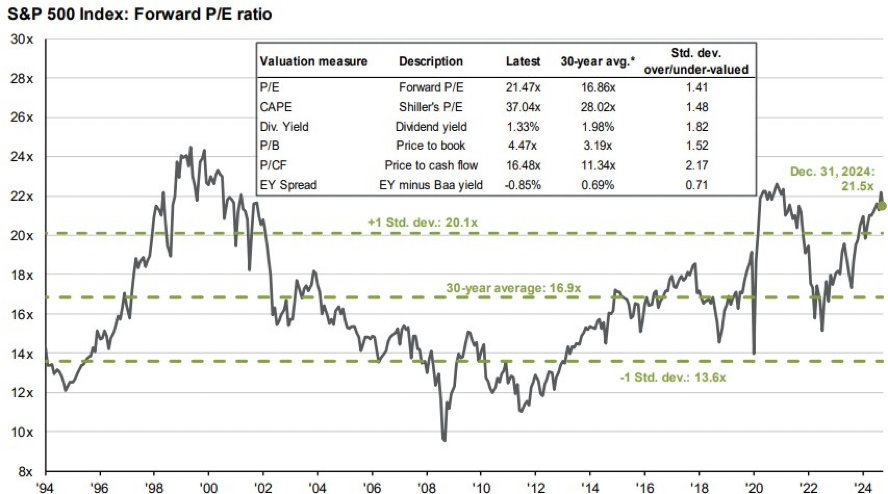January 2025 – Economic and Market Update
AN ECONOMIC AND MARKET UPDATE
January 2025
EXECUTIVE SUMMARY
- Markets ended 2024 up on the year across all major asset classes, but with the Magnificent 7 scuffling a bit.
- 2025 looks setup for solid economic growth that may not live up to growth expectations.
- Fixed income investing is on solid footing with rates in the 5% range making for an attractive place to keep the low risk portion of your portfolio.

The end of 2024 came in on a little bit of a downer for what was otherwise a strong performing year, at least as far as the S&P 500 is concerned. As you can see in the chart above, U.S. large cap companies, dominated by the Magnificent 7, drove strong market returns. All other major asset classes also ended the year with positive but not spectacular returns. The Federal Reserve did reduce the Fed Funds Rate in December by a quarter-point to the 4.25 – 4.5 percent range. Whether or not they continue to cut is a good question and one that seems to swing the market every time data is released. Markets rise when economic data comes in weak and markets fall when economic data comes in strong. All of that movement is driven by anticipation of what the Federal Reserve will do either in cutting, holding, or increasing rates. It is a strange time to be a Fed watcher.
Cryptocurrencies are once again front and center with the major coins showing dramatic increases in value in 2024. We do not advise on cryptocurrency investing for clients. We are well-versed in the taxation of crypto, but investing in crypto is not something that we recommend or educate clients on. The advice of “buyer beware” feels appropriate when it comes to how you approach this particular asset class. Don’t forget that cryptocurrency does not make a product or provide a service. Our recommendation is to not invest more than 5% of your portfolio in a single holding, particularly if it is speculative like crypto.
2025 FORECAST
The market moving significantly based on assumptions about what the Fed may or may not do is not a comfortable place to be, but that is where we are right now. The Federal Reserve, in turn, may be waiting to see whether some of the more drastic policies discussed on the campaign trail are passed via Congress or Executive Order. This is important because some of the policies, such as large tariff increases, are potentially inflationary. We are in wait-and-see mode barring economic data turning in a clear direction.
The yield curve is beginning to get closer to normalisation, although it is still inverted. The premium for longer term bonds has risen and with it the yield curve has shifted up at the far end of the scale. At the short end we are still suffering through an inversion as you can see below. The current yield curve is represented by the dark blue line. Fixed income investing will be negatively impacted if rates are increased, however, current yields are now making it attractive to be in the fixed income asset class. Additionally, if the economy does soften and rate decreases are in our future, fixed income should rise with the cutting of rates. Postive real rates, meaning that inflation is less than the fixed income yield, makes bond investing attractive at this point in the economic cycle.

Source: FactSet, Federal Reserve, J.P. Morgan Asset Management, Guide to the Markets – U.S. Data are as of December 31, 2024
Productivity growth is the name of the game in the United States. If artificial intelligence (AI), and other related technologies, are able to prove their worth it would be a significant boon to the growth prospects of the U.S. and the world.

Source: Vanguard calculations, using data from the Federal Reserve Bank of St. Louis, as of September 30, 2024
If the economy successfully navigates inflation and truly comes to a soft landing, which it is appearing to do, a return to higher levels of productivity growth will be what allows us to grow out of the debt and demographic trap that we are in. AI is the most likely way forward. Like the internet before it, the process of rolling out AI technology will be messy and the winners will likely be those who adopt and adapt to the technology first. Our hope is that it allows people to spend more time on people. Creative problem solving and interactions more than the robotic tedious tasks which a computer can handle so easily. The forecast for productivity growth is visible in the graph above as the teal portion of each column. Productivity stalled in the 2010’s. The forecast is for much more consistent productivity growth in the future.
All of this leads to the question of what will the market do in 2025.

Source: FactSet, FRB, Refinitiv Datastream, RobertShiller, Standard & Poor’s, Thompson Reuters, J.P.Morgan Asset Management
Guide to the Markets – U.S. Data are as of December 31, 2024
Our expectation is that the economy will perform relatively well in 2025. The problem is that we do not think it will live up to the expectations that are undergirding the high Price-to-Earnings ratios we are experiencing right now. In the final stretch of 2024 the Magnificent 7 stocks began to underperform. For the year they drove returns in the S&P 500, but at the end of the year they scuffled and have carried that underperformance into 2025. We see the strategy for this year being one where continued diversification will be key to minimizing outsized drawdowns if growth for these companies does not materialize in the amount necessary to justify their current PE ratios.
THE ANTI-SMISHING SECURITY POST
There is a new kid on the block when it comes to the long history of scamming.
In the ever-evolving landscape of digital fraud, a new breed of malicious scams has gained traction: “smishing.” Smishing—short for “SMS phishing”—is the fraudulent practice of sending misleading text messages designed to trick recipients into sharing personal, sensitive, or financial information. While phishing via email remains a familiar threat, smishing exploits a more direct and immediate line of contact: our mobile devices. Below, we delve into how smishing scams work, what they look like, and, most importantly, how you can protect yourself.
1. What is Smishing?
Smishing is a specific type of cyberattack where a scammer sends fraudulent text messages to manipulate recipients into giving up personal information such as passwords, credit card numbers, Social Security numbers, and other sensitive data. In many cases, these messages seem urgent and pose as trusted entities—like banks, government agencies, or well-known companies—to appear legitimate.
A typical smishing message might:
- Announce that your bank account has been locked and prompt you to “verify” your information.
- Claim you’ve won a contest or lottery and need to follow a link to claim your prize.
- Pose as a delivery service that requires an immediate update of your information or payment to complete a package delivery.
2. Common Tactics Used by Smishers
Sense of Urgency
Attackers often frame the message as an emergency (e.g., “Your account will be closed unless you click the link”) to evoke panic and encourage immediate action.
Use of Official-Looking Details
To add credibility, scammers may replicate elements like logos or standardized text commonly used by real banks, government agencies, or service providers.
Phony Links or Redirects
The text will often include a shortened or disguised link to a malicious website. Clicking that link can lead to a form prompting you to divulge sensitive information or download harmful software.
Requests for Personal Information
Whether it’s a PIN, credit card number, Social Security number, or online banking password, the message urges users to disclose details under the guise of verification or troubleshooting.
Spoofed Sender Names
Cybercriminals can manipulate the sender ID, making the message appear as if it is coming from a legitimate company or financial institution.
3. How to Identify a Smishing Attempt
Unexpected or Unsolicited Texts
If you receive a message about an account you never opened or a service you’ve never used, it’s likely a scam.
Generic Greetings and Grammatical Errors
Texts that say “Dear Customer” without mentioning your name, or that contain grammatical mistakes, can be telltale signs of a scam.
Suspicious Links
A link that looks jumbled, shortened, or doesn’t match the supposed sender’s official website can be an indicator of fraud.
Immediate Action or Consequence
If a text threatens you with account closure, fines, or other penalties unless you “act now,” it’s wise to double-check its authenticity.
Requests for Confidential Information
Legitimate institutions do not typically request sensitive data (like passwords or full Social Security numbers) via text messages.
4. How to Protect Yourself from Smishing
Never Click on Suspicious Links
Avoid clicking links from unknown or unverified senders. If you think the message might be legitimate, directly visit the organization’s official website or call their customer service line for verification.
Don’t Share Personal Information via Text
A reputable business will rarely, if ever, request sensitive information over SMS. If in doubt, call the company using their official phone number.
Verify the Sender
If a text claims to be from your bank or a well-known business, call the organization’s publicly listed phone number (not the number in the text) to confirm whether the message is real.
Enable Spam Filters
Some mobile carriers and messaging apps offer spam-blocking services. Look into your smartphone’s built-in spam filter or third-party applications that can help identify and block potential smishing messages.
Keep Your Device and Apps Updated
Regularly update your phone’s operating system and messaging apps. These updates often include security patches that protect against newly discovered vulnerabilities.
Use Security Software
Install a reputable mobile security app that can scan messages and alert you to potential threats, including malicious links.
Remain Informed
Stay current on the latest smishing and phishing techniques. Cybercriminals are inventive; knowing their methods is your first line of defense.
5. What to Do If You Suspect You’re a Victim
Stop Engaging
If you clicked on a suspicious link or replied to a scam text, cease contact immediately.
Change Your Passwords
If you may have shared account details, update your passwords immediately—beginning with your email and online banking accounts.
Contact Your Bank
If you entered any financial information, contact your bank or credit card company right away. They can monitor transactions and help protect you from further fraud.
Report the Incident
Report the smishing message to your mobile carrier by forwarding the suspicious text to 7726 (SPAM) if that service is available in your region. You can also file a complaint with consumer protection agencies or law enforcement in your country.
Smishing capitalizes on our dependence on mobile devices, using deceptive text messages to manipulate unsuspecting users into divulging sensitive information. As this form of phishing becomes more sophisticated, awareness and vigilance are paramount. By recognizing the tactics cybercriminals use—such as urgent pleas and suspicious links—and knowing how to respond, you can effectively protect yourself from smishing schemes. Always remember: when in doubt, verify independently. A moment of caution can save you from a world of trouble.
If you’re wondering just how convincing this type of fraud can be or how easily someone might be deceived by it, consider this: can you tell whether the entire “Smishing” section of this update was written by a computer? Here’s a hint: it was.
Our commitment to guiding you through these evolving economic conditions remains unwavering. We encourage you to reach out with any questions or concerns as we continue to move forward in an uncertain world.
DISCLOSURE
This material is for general information only and is not intended to provide specific advice or recommendations for any individual. There is no assurance the views or strategies discussed are suitable for all investors or will yield positive outcomes. Investing involves risks including possible loss of principal. Any company names noted herein are for educational purposes only.
All information is believed to be from reliable sources; however we make no representation as to its completeness or accuracy. All economic and performance data is historical and not indicative of future results. Market indices discussed are unmanaged. Investors cannot invest in unmanaged indices. Additional risks are associated with international investing, such as currency fluctuations, political and economic instability and differences in accounting standards.
Investing in securities in emerging markets involves special risks due to specific factors such as increased volatility, currency fluctuations and differences in auditing and other financial standards. Securities in emerging markets are volatile and can decline significantly in response to adverse issuer, political, regulatory, market, or economic developments.
An index is a statistical measure of change in an economy or a securities market. In the case of financial markets, an index is an imaginary portfolio of securities representing a particular market or a portion of it. Each index has its own calculation methodology and is usually expressed in terms of a change from a base value. Thus, the percentage change is more important than the actual numeric value. An investment cannot be made directly into an index.
Investing in fixed income securities involves credit and interest rate risk. When interest rates rise, bond prices generally fall. Investing in commodities may involve greater volatility and is not suitable for all investors. Investing in a non-diversified fund that concentrates holdings into fewer securities or industries involves greater risk than investing in a more diversified fund. The equity securities of small companies may not be traded as often as equity securities of large companies so they may be difficult or impossible to sell. Neither diversification nor asset allocation assure a profit or protect against a loss in declining markets. Past performance is not an indicator of future results.
Financial Planning offered through Reason Financial, a state Registered Investment Advisor. Investment advice offered through Merit Financial Group, LLC an SEC Registered Investment Advisor. Merit Financial Group and Reason Financial are separate entities. Tax related services offered through Reason Tax Group. Reason Tax Group is a separate legal entity and not affiliated with Merit Financial Group, LLC. Sean P. Storck CA Insurance Lic#OF25995 and Steven W. Pollock CA Insurance Lic#OE98073
Copyright © 2024 Reason Financial all rights reserved.
